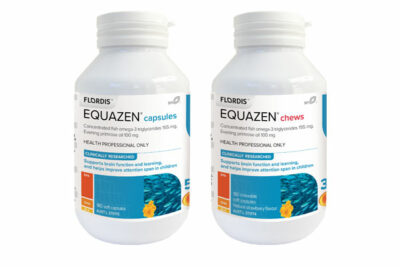How essential fatty acids omega-3 and omega-6 can help to support healthy brain function of children.
The human brain takes approximately 25 years to fully develop, so the early years, especially between ages 3 and 7, are some of the most important years for our brain development.
Parents need to look after and support the development of their child’s brain from an early age, ensuring them the opportunity to thrive throughout life. Establishing strong foundations in youth, while the brain is developing, puts children in a strong place to succeed and thrive in life. Through simple nutritional practices we can strengthen our children’s ability to learn, concentrate and stay focused.
The right ratio of essential fatty acids is essential to this. As our brain is 60% fat, and 35% of these fats are what we call polyunsaturated fatty acids, including the essential omega-3 and omega-6 fatty acids: EPA, DHA and GLA. These three essential fatty acids are able to enhance children’s cognitive functions and learning ability when provided in the right quantity.
What are PUFAs?
Polyunsaturated fatty acids (PUFAs) are essential fats that the body requires for brain function and cellular growth. From the very first moment, omega-3 and omega-6 PUFAs are essential for human brain development. During pregnancy, the mother provides the baby with all the PUFAs required for brain development. Throughout childhood, the PUFAs intake required for brain development and learning relies on external sources of food and nutrition, and quite often modern diets don’t provide enough essential fatty acids.
Ensure children receive adequate PUFA’s from their diet by including fish, avocados, raw unsalted nuts & seeds, good quality oils and limit processed packaged foods with higher trans and saturated fat content. PUFA’s are also available in supplements if advised.
What is the 9:3:1 unique balanced ratio? And how does it support brain function?
The modern Western child’s diet is typically deficient in omega-3 fatty acids and has an excessive amount of omega-6 fatty acids. This imbalance is is not optimal to support brain health and is linked to all sorts of medical conditions and diseases like cardiovascular, inflammatory and autoimmune diseases.
One option to get a balanced ratio of omega-3 and omega-3 is to re-think your diet and ensure you consume a balanced ratio of these fatty acids and add foods high in these to the family dinner plate. For the basics, we have the list below:
- Foods high in Omega-6: walnuts, chia seeds, sunflower seeds, tody, eggs, almonds
- Foods high in Omega-3: mackerel, salmon, cod liver oil, soybeans, chia sees
A simpler option may be to take a PUFA supplement with a balanced ratio of EPA:DHA:GLA.
Epzen by Flordis has a specific 9:3:1 proportion that promotes brain function.1-3
- 9 parts of EPA, eicosapentaenoic acid, an omega-3
- 3 parts of DHA, docosahexaenoic acid, an omega-3
- 1 part of GLA, gamma-linolenic acid, an omega-6
The Flordis Equazen range provides the clinically researched1-3 EPA/DHA/GLA 9:3:1 blend, sourced from concentrated fish oil omega-3 triglycerides and evening primrose oil.
Equazen has been researched in many randomised, double blind, placebo-controlled studies, with a good tolerance profile. Studied in over 19 clinical trials and included in multiple reviews/meta-analyses, with over 15 years of ongoing research and global use. The EQUABALANCE ratio of EPA/DHA/GLA 9:3:1 provides a higher level of the important omega-3 EPA with the additional support of DHA. Research shows this EQUABALANCE ratio to have multiple beneficial outcomes and to lower the omega-6/omega-3 ratio.1-3
In these studies, Equazen proved to be significantly effective in supporting learning, improving attention span, concentration, focus, and learning capabilities such as reading and writing.
This medicine may not be right for you. Read the label before purchase. Follow the directions for use.
References:
- Richardson AJ et al. The Oxford-Durham study: A randomized, controlled trial of dietary supplementation with fatty acids in children with developmental coordination disorder. 2005;115(5):1360-1366.
- Johnson M et al. Omega 3/6 fatty acids for reading in children: a randomized, double-blind, placebo-controlled trial in 9-year-old mainstream schoolchildren in Sweden. J Child Psychol Psychiatry. 2017;58(1):83-93 [epub 2016].
- Johnson M et al. Fatty acids in ADHD: plasma profiles in a placebo controlled study of omega 3/6 fatty acids in children and adolescents. Atten Defic Hyperact Disord. 2012;4(4):199-204





